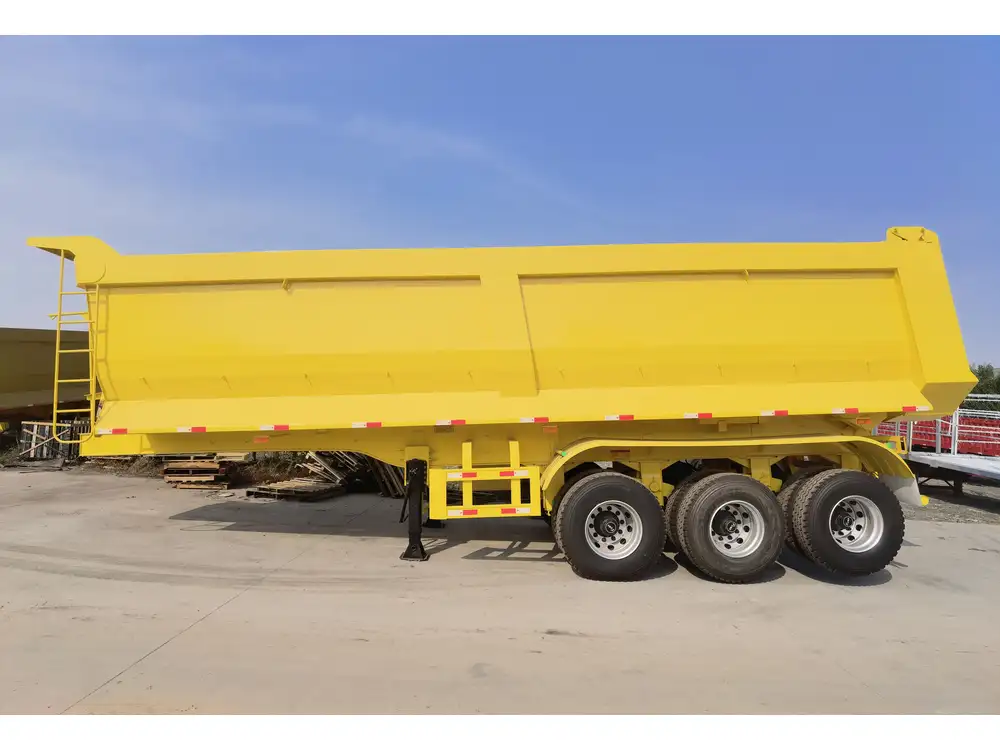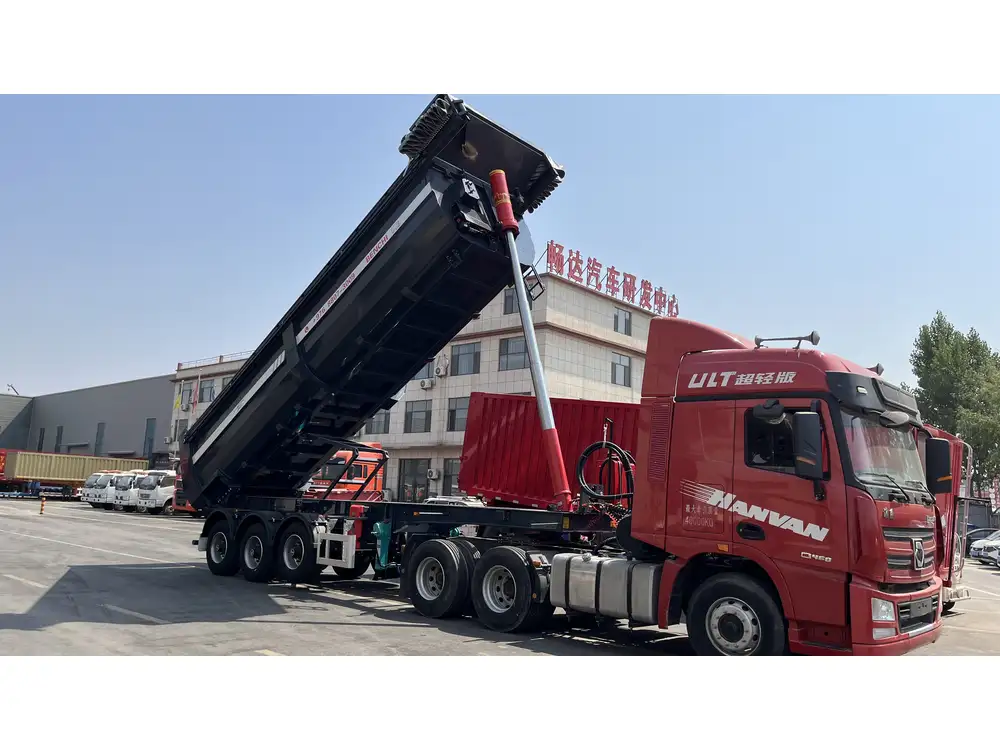In the expansive world of construction, landscaping, and various hauling operations, dump trailers offer unparalleled utility. This article delves deep into one pivotal question: how much dirt can a dump trailer hold? For professionals in the industry, understanding the capacity of dump trailers is crucial for effective project planning and execution. We will explore the various capacities, types of dump trailers, and factors influencing their load capacity.
1. Dump Trailer Capacity Breakdown
1.1 Types of Dump Trailers
Not all dump trailers are created equal, and their capacities vary significantly based on their design and purpose. Here’s a brief overview of the different types commonly utilized:
| Type of Dump Trailer | Typical Capacity | Best Suited For |
|---|---|---|
| Single Axle Dump Trailer | 5,000 – 10,000 pounds | Small to medium-sized projects |
| Tandem Axle Dump Trailer | 10,000 – 25,000 pounds | Large projects and heavier loads |
| Tri-Axle Dump Trailer | 25,000 – 30,000 pounds | Heavy-duty hauling |
| End Dumps | 15,000 – 30,000 pounds | Rapid unloading of loose materials |
| Side Dumps | 20,000 – 30,000 pounds | Unloading in confined spaces |

1.2 Typical Capacity Specs
Understanding the exact measurements is paramount. Generally, the capacity of a dump trailer is expressed in terms of weight (pounds) and volume (cubic yards). Most dump trailers can hold between 5 to 25 cubic yards, depending on their configuration:
- Small Dump Trailers (often found in landscaping): Usually hold about 5 to 10 cubic yards of dirt.
- Medium Dump Trailers: Generally can accommodate 10 to 15 cubic yards of material.
- Large Dump Trailers: Ideal for commercial or extensive construction projects, these can range from 15 to 25 cubic yards.
Here’s a quick table expressing this capacity in weight based on average dirt density:
| Cubic Yards | Approximate Weight (lbs) |
|---|---|
| 5 cubic yards | 10,000 lbs |
| 10 cubic yards | 20,000 lbs |
| 15 cubic yards | 30,000 lbs |
| 20 cubic yards | 40,000 lbs |
| 25 cubic yards | 50,000 lbs |
2. Key Factors Influencing Load Capacity
2.1 Trailer Construction and Design
The construction of a dump trailer significantly impacts its capacity. Materials such as steel and aluminum vary in weight and strength, leading to different capabilities.
- Steel Dump Trailers: Typically more robust but heavier, leading to less payload capacity.
- Aluminum Dump Trailers: Lighter, allowing for higher payload without exceeding weight limits.

Comparison Table: Steel vs. Aluminum
| Material | Weight | Strength | Cost | Capacity |
|---|---|---|---|---|
| Steel | Heavier | Very Strong | Usually Cheaper | Lower Payload |
| Aluminum | Lighter | Strong Enough | More Expensive | Higher Payload |
2.2 Axle Configuration
The number of axles influences not just the weight distribution but also the legal weight limits. More axles generally allow for higher loads.
- Single Axle: Best for lighter loads, often up to 10,000 pounds.
- Tandem Axle: Can handle loads from 10,000 to 25,000 pounds.
- Tri-Axle: Facilitates heavy-duty transport, capable of handling loads upwards of 30,000 pounds.
2.3 Legal Weight Limits
Navigating through DOT regulations is essential for anyone operating dump trailers. Each state has specific weight restrictions, usually articulated in terms of Gross Vehicle Weight (GVW).
| GVW Limit | Impact on Load Capacity |
|---|---|
| Under 10,000 lbs | Operate without special permits. |
| 10,000 – 26,000 lbs | May require a commercial driver’s license (CDL). |
| Over 26,000 lbs | Requires special permits and compliance with axle limits. |

3. Calculating Dirt Capacity
3.1 Volume to Weight Conversion
Understanding how much dirt a dump trailer can hold involves translating volume (cubic yards) into weight (pounds). The density of the material is a vital part of this equation:
- Average Dirt Density: Approximately 1,600 to 2,000 pounds per cubic yard.
Hence, our calculations would manifest in this manner:
[ \text{Weight Capacity (lbs)} = \text{Cubic Yard Capacity} \times \text{Density (lbs/cubic yard)} ]For instance, a tandem axle trailer with a capacity of 15 cubic yards filled with standard topsoil would have: [ \text{Weight} = 15 \, \text{cubic yards} \times 1,800 \, \text{lbs/cubic yard} = 27,000 \, \text{lbs} ] The implications here suggest that operators should always consider actual density, as wet or sandy soil will weigh significantly more.
3.2 Practical Loading Guidelines
To prevent overloading, which may lead to structural damage or legal penalties, applying these practical loading guidelines is paramount:
- Always Check Manufacturer Specifications: Each trailer has a unique load capacity.
- Distribute Weight Evenly: Proper weight distribution ensures stability and safety.
- Consider Material Type: As noted, moist or compacted dirt can exceed typical weight predictions.

4. Maintenance and Safety Considerations
4.1 Routine Inspections
Ensuring the safety and reliability of dump trailers encompasses regular maintenance routines. Adhering to a structured maintenance schedule helps prevent breakdowns and extends the trailer’s lifespan:
- Check Brakes and Lights: Critical for safe hauling.
- Inspect Axles and Tires: Regular checks for wear ensure safe operation.
- Frame and Hinge Inspection: Assess for any signs of rust or structural fatigue.
4.2 Driver Training and Compliance
Proper training emphasizes the importance of adhering to regulations and understanding the trailer’s limits. Operators should receive training on safe loading practices, weight distribution, and awareness of local regulations.

4.3 Risk Management
Operating dump trailers can be risky. Here’s a structured approach to managing risks:
- Assess the Load: Always evaluate the type and amount of material being loaded.
- Secure Loads Properly: Use tarps or nets to prevent material from spilling.
- Monitor Weather Conditions: Steer clear of operation during adverse weather, especially when hauling wet materials.
5. Conclusion
The question of how much dirt can a dump trailer hold is not solely about the numerical capacity; it involves a thorough understanding of the various trailer types, their construction, legal considerations, and operational best practices. We trust this comprehensive overview equips industry professionals with the necessary knowledge to optimize their use of dump trailers effectively. By marrying rigorous capacity calculations with routine maintenance and compliance, contractors can elevate project outcomes while ensuring safety and efficiency.
Each trailer serves a unique purpose and selection hinges on project specifications; hence, choosing the right dump trailer for your next project is vital to enhancing productivity and ensuring compliance with legal mandates. We encourage you to reach out with any further inquiries regarding our comprehensive range of dump trailers and associated capacities. Your operational success begins with informed choices, and we’re here to assist every step of the way.



